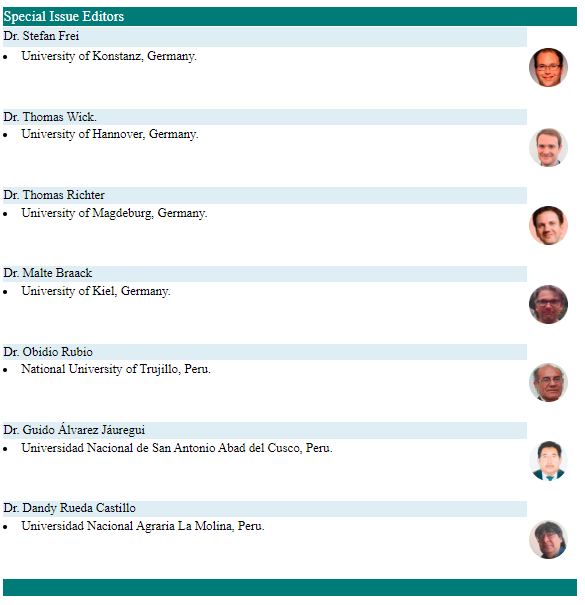Influence of the prey refuge use on the Volterra predation model
Uso de refugio por las presas en el modelo Volterra
DOI:
https://doi.org/10.17268/sel.mat.2024.01.05Keywords:
Predator-prey model, refuge, stability , bifurcations , limit cycles , separatrix curvesAbstract
In various previous works, different predation models have been analyzed considering the use of refuge by the prey population, without carrying out an exhaustive analysis of its dynamics.
In some of them it is stated that the use of shelters or dens by a fraction of the prey population has a stabilizing effect on predator-prey interaction. One of the objectives of this work is to show that some of these new systems considering refuge may have the same topological portrait in the phase plane as the original; but in others the dynamics change strongly.
In our research we will introduce modifications to the well-known Volterra model, considering various ways to express the number of prey in refuge. In several of them, local dynamics equivalent to the original model are obtained, confirming that results reported as new were previously known based on the original system, without taking into account the refuge of the prey. We conclude that the behavior of the systems depends on the mathematical expression to describe the number of sheltered prey.
References
Volterra V.. Variazioni e fluttuazioni del numero de individui in specie animali conviventi, Memorie della R. Accademia dei Lincei, S.VI, IT. 2 (1926) 31-113.
May RM. Stability and complexity in model ecosystems. (2nd edition): Princeton University Press, 2001.
Turchin P. Complex population dynamics. A theoretical/empirical synthesis, Mongraphs in Population Biology 35. Princeton University Press, 2003.
González-Olivares E, Ramos-Jiliberto R. Consequences of prey refuge use on the dynamics of some simple predator-prey models: Enhancing stability?, In R. Mondaini (ed.), Proceedings of the Third Brazilian Symposium on Mathematical and Computational Biology (BIOMAT-2003), E-Papers Servic¸os Editoriais Ltda., Rio de Janeiro, 2004; 2:75-98.
González-Olivares E, López-Cruz R, Rojas-Palma A. Uso de refugio por las presas: su impacto en la dinámica del modelo de Lotka-Volterra, Selecciones Matemáticas, 2022; 9(2):287-301.
Berryman AA, Gutierrez AP, Arditi R. Credible, parsimonious and useful predator-prey models - A reply to Abrams, Gleeson, and Sarnelle, Ecology. 1995; 76(6):1980-1985.
Taylor RJ, Predation. Chapman and Hall, 1984.
Ramos-Jiliberto R, Gonz´alez-Olivares E. Relating behavior to population dynamics: a predator-prey metaphysiological model emphasizing zooplankton diel vertical migration as an inducible response, Ecological Modelling. 2000; 127: 221-233.
González-Olivares E, González-Yañez B, Becerra-Klix R, Ramos-Jiliberto R . Multiple stable states in a model based on predator-induced defenses, Ecological Complexity. 2017; 32:111-120.
Harrison GW. Global stability of predator-prey interactions. J. of Math. Biol. 1979; 8:139-171.
Sih A. Prey refuges and predator-prey stability. Theor. Popul. Biol. 1987; 31:1-12.
Freedman HI. Deterministic Mathematical Model in Population Ecology. Marcel Dekker. 1980.
Gause GF. The Struggle for Existence. The Williams & Wilkins company. Baltimore, 1934.
Molla H, Sabiar Rahman M, Sarwardi S. Dynamics of a predator-prey model with Holling type II functional response Incorporating a prey refuge depending on both the species. Int. J. of Nonlinear Sci. and Num. Sim. 2019; 20(1):89-104.
Collings JB. Bifurcations and stability analysis of atemperature-dependent mite predator-prey interaction model incorporating aprey refuge, Bulletin of Mathematical Biology 57 (1995) 63-76.
Maynard Smith J. Models in Ecology. Cambridge University Press, 1974.
Ruxton GD. Short term refuge use and stability of predator-prey models. Theor. Pop. Biol. 1995; 47:1-17.
González-Olivares E, González-Yañez B, Becerra-Klix R, Prey refuge use as a function of predator-prey encounters, Private communication, submitted to Int. J. of Biomathematics(2021).
Almanza-Vásquez E. Dinámicas de modelos de depredación, considerado una función con saturación para el uso de refugio por parte de las presas[Tesis Maestría], Facultad de Ciencias Básicas y Tecnologías, Universidad del Quindío, Armenia, Colombia 2007.
Almanza-Vásquez E. González-Olivares E, González-Yañez B. Dynamics of Lotka-Volterra model considering satured refuge for prey, In R. Mondaini (Ed.) BIOMAT 2011 International Symposium on Mathematical and Computational Biology, World Scientific Co. Pte. Ltd. 2012; 62-72.
Haque M, Sabiar Rahman M, Venturino E, Li B-L. Effect of a functional response-dependent prey refuge in a predator-prey model. Ecol. Complex. 2014; 20:248-256.
Goh B-S. Management and Analysis of Biological Populations. Elsevier Scientific Publishing Company. 1980.
Clark CW. Mathematical Bioeconomic. The optimal management of renewable resources. John Wiley and Sons. 1990.
González-Olivares E, Ramos-Jiliberto R. Dynamic consequences of prey refuges in a simple model system: more prey, fewer predators and enhanced stability, Ecol. Model. 2003; 166: 135-146.
Chicone C. Ordinary Differential Equations with Applications. Texts in Applied Mathematics. Springer, New York, 2008.
McNair JM. The effects of refuges on predator-prey interactions: a reconsideration. Theor. Popul. Biol.1986; 29:38-63.
Downloads
Published
How to Cite
Issue
Section
License
Copyright (c) 2024 Selecciones Matemáticas

This work is licensed under a Creative Commons Attribution 4.0 International License.
The authors who publish in this journal accept the following conditions:
1. The authors retain the copyright and assign to the journal the right of the first publication, with the work registered with the Creative Commons Attribution License,Atribución 4.0 Internacional (CC BY 4.0) which allows third parties to use what is published whenever they mention the authorship of the work And to the first publication in this magazine.
2. Authors may make other independent and additional contractual arrangements for non-exclusive distribution of the version of the article published in this journal (eg, include it in an institutional repository or publish it in a book) provided they clearly state that The paper was first published in this journal.
3. Authors are encouraged to publish their work on the Internet (for example, on institutional or personal pages) before and during the review and publication process, as it can lead to productive exchanges and to a greater and more rapid dissemination Of the published work.












